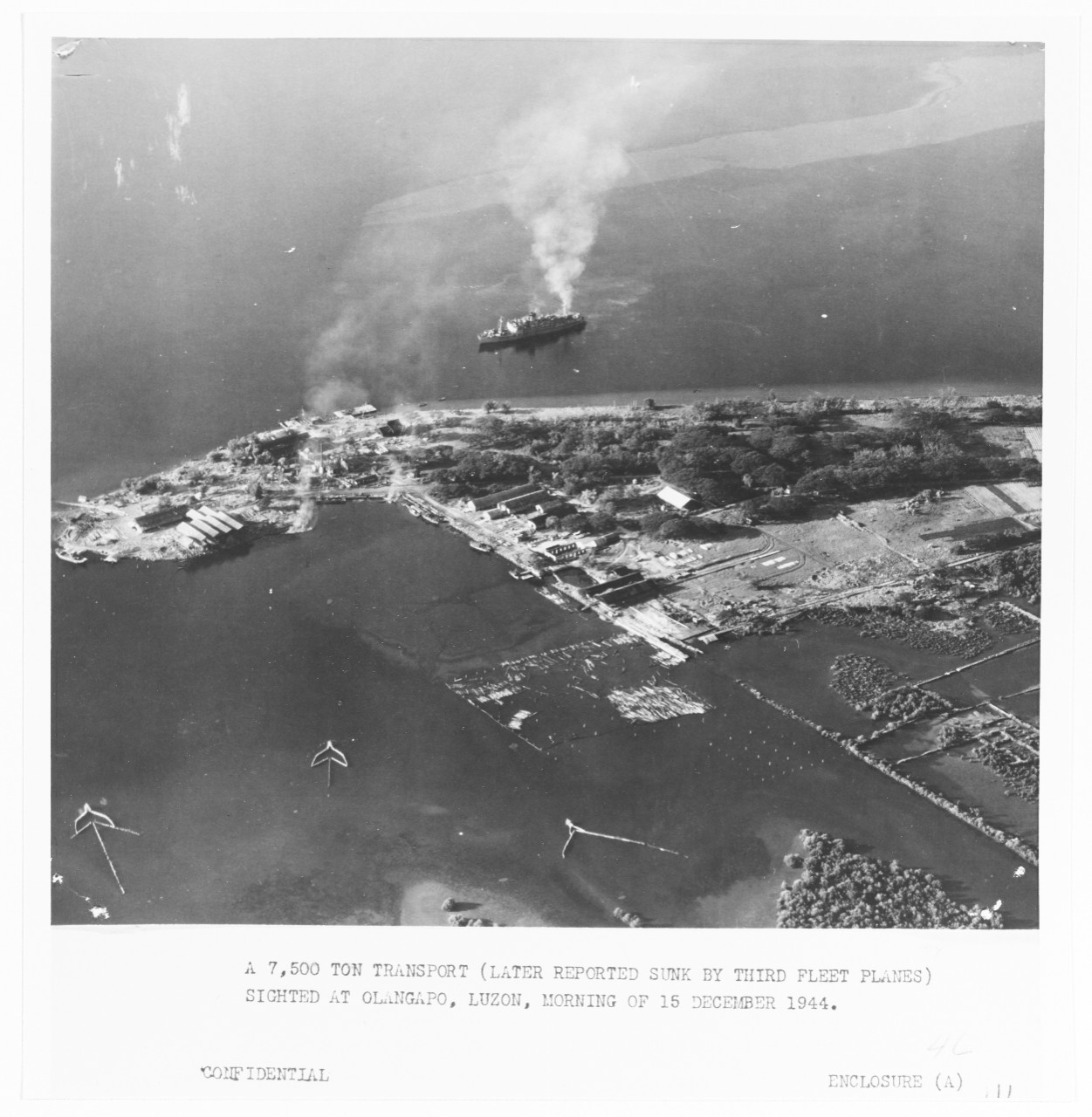Japanese PoW Hell :Ships
"The heat was terrific and the air stifling.""Men were bathed in sweat immediately and began to pass out from suffocation and dehydration."Hell Ship survivor"Allied prisoners of war called them 'hell ships', the requisitioned merchant vessels that the Japanese navy overloaded with PoWs being relocated to internment on the Japanese Home Islands or elsewhere in the empire.""The holds were floating dungeons, where inmates were denied air, space, light, bathroom facilities, and adequate food and water—especially water.""Thirst and heat claimed many lives in the end, as did summary executions and beatings, yet the vast majority of deaths came as a result of so-called 'friendly fire' from U.S. and Allied naval ships, submarines, and aircraft."U.S. Naval History and Heritage Command
 |
| Aerial photo taken from a USS Hancock (CV-19) plane depicting the sinking of the Japanese ship Oryoku Maru off the coast of Luzon, Philippine Islands, 15 December 1944 (NH 95603). |
Hundreds of unidentified remains of Second World War prisoners of war killed on Japanese prison vessels called "hell ships" were interred following the war in a cemetery in Hawaii. The remains of these American servicemen who died or were killed while being transported in the holds of squalid prison ships off the coasts of the Philippines and Taiwan in late 1944 and early 1945 are to undergo scrupulous examination and DNA identification. A scant few of these servicemen were identified initially by their dog tags, but the vast majority had nothing to identify them.
The Defense POW/MIA Accounting Agency (DPAA), out of Crystal City, Virginia will be managing this project to account for the missing and unidentified servicemen from past wars. Most of these servicemen had been captured as prisoners-of-war by the Japanese in the Philippines in the early years of the war and at the time they were loaded on to these hell ships had already suffered years of deprivation in their internment in prisoner-of-war camps where brutality was the order of the day.
They were packed unceremoniously in the ships, their destination Japanese labour camps. Some of these prisoners starved to death on board, or they suffocated in the foul, sweltering holds, while others lost their minds and fellow prisoners put them out of their misery. And nor were some spared being shot by Japanese guards. But many, many more lost their lives when the prison ships were bombed by U.S. planes piloted by personnel who had no idea that U.S. PoWs were in the ships' holds.
The intention of the DPAA initially was its focus on a large group of unidentified servicemen buried in a mass grave in southern Taiwan when the hell ship they were suffocatingly cloistered in, the Enoura Maru, was attacked on January 9, 1945 by American warplanes. According to historian Gregory Michno in his 2001 book, "Death on the Hell-ships", 300 men were killed when a bomb blew up close to the ship's forward hold.
Survivor John Jacobs recalled "There was a blinding orange flash and a deafening explosion". Jacobs' experience recorded in the National Archives magazine Prologue, had him peering into a hole produced by the bomb: "There were mangled Americans, some 300 of them, piled three deep and pinned down with large steel girders and hatch covers", he had reported. Several days later the bodies were taken ashore and stacked on barges where some may have been cremated but most were buried on the beach.
| Montevideo Maru - the freighter's sinking was Australia's worst ever maritime disaster PNG Attitude |
The ships were headed for Japan, the intention was to bring the starving, injured prisoners from the Philippines to Japan. About 1,600 U.S. prisoners were packed aboard the hell ship Oryoku Maru on December 12, 1944 from a Manila pier. Horses had previously been carried in the broiling holds where the PoWs were crowded in, still befouled with manure, creating an excruciating stench, the air so thick and heated breathing was heavily compromised and men were retching-sick. When the ship got underway the following day it was attacked by roving U.S. planes.
Although the ship found mooring in nearby Subic Bay, the next morning the planes discovered its presence and once again attacked. The ship sank and at the last moment the PoWs were permitted to dive into the water which was soon full of desperate prisoners. Some of the PoWs were machine-gunned by Japanese guards who felt they were attempting to escape. Those that survived were transported overland to another Philippine port where most were put aboard the Anoura Maru. Two days later it arrived in Taiwan where it was once again attacked by U.S. planes.
Those who survived once again, were taken on to Japan to become slave labourers. When the war finally ended, those who survived the never-ending nightmare were liberated months later. A year later a U.S. graves registration team travelled to Takao beach to begin exhuming remains, which were divided into caskets, each containing ten 'individuals' to be shipped to a mausoleum outside Honolulu and reburied in the National Memorial Cemetery of the Pacific where the DPAA plans to exhume and with the use of new technologies attempt their identification.
"We'll do a full digital inventory of every bone.""We'll take measurements where we can [and assemble bones that seem to go together]."Katherine Skorpinski, anthropologist, Omaha
Labels: Hell Ships, Japan, U.S. Graves Commission, U.S. Prisoners of War, World War II
0 Comments:
Post a Comment
<< Home